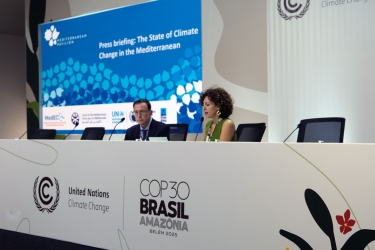Open letter from Marc Palahí

Forestry combating climate change: an inconvenient truth?
For the last two years a heated debate has been ongoing in Europe on what is the best way to unlock the potential of our forests to fight climate change. The debate is not easy for several reasons:
- The climate policy framework of Land Use, Land Use Change and Forestry (LULUCF) and how forests are included in it is complicated to understand. It is also complicated to communicate, and discuss with the policy makers responsible for deciding on it.
- The debate has been hijacked by short-term and segregated approaches. These either emphasize the sink in the forest, or the products and bio-energy aspects of the mitigation, and forget long-term adaptation questions.
- The spread of misinformation regarding the situation of European forests, and the potential of forestry to address the problem of climate change, has been growing.
In this context, I would like to share some important facts and reflections.
Science-based facts on EU forestry and climate change
The EU forest carbon sink has maintained its strength over the last three decades. The EU28 currently has 161 million hectares of forests, corresponding to 37% of its total land area. The forest area has expanded for decades. Since 1990 it has increased by 9%, while the growing stock has increased by 38%.
Increased attention has been paid to biodiversity conservation. The area of mixed forests has increased, the amount of dead wood slightly increased, and the area of protected forest has grown.
EU forests, which are predominantly (85%) managed, are our most important source of non-food and non-feed renewable biological resource. According to international statistics, EU forests supplied 447 million mᶾ of roundwood in 2015. Approximately 70% of the EU wood annual increment is harvested, but with high variation among European countries and regions. The fact that harvest levels are below increment has resulted in an annual sink in EU forests of around 435 Mt CO₂/y for the years 1990 to 2012, representing over 10% of total EU greenhouse gas emissions in 2012. When carbon storage via harvested wood products (HWP) is also taken into account, this adds another 35 to 44 Mt CO₂ mitigation impact annually (depending on the time period used as reference), i.e. equal to up to 1% of EU greenhouse gas emissions.
The material substitution effect of the production of long-life wood products, such as wood used in construction, can be estimated to help to avoid some 2% (or 90 Mt CO₂/y) of EU greenhouse gas emissions.
This means that EU forests, forestry and forest bioeconomy solutions are estimated to produce an overall climate change mitigation effect of about 13% of the total EU greenhouse gas emissions. In fact, a recent study suggests that this contribution could be even doubled, if the right incentives are provided to support afforestation, forest management and the substitution of fossil-based products by forest-based solutions (e.g., wood construction).
Forest-based reflections
There is no doubt that climate change is an urgent problem that requires short-term actions. Short-term positive forestry measures to mitigate climate change are possible, especially by reducing deforestation globally, and by addressing the increasing impact of natural disturbances like forest fires, which are significant sources of GHG emissions.
But any forestry mitigation strategy should also take into account that in the future carbon-intense industrial sectors (e.g. construction, which predominantly relies on concrete and steel), as well as sectors relying on fossil-based resources (e.g. textiles, chemicals or plastics) will need to transform towards fossil free and renewable solutions. This is necessary to enable the decarbonisation of our economy while meeting the increasing demands of a growing population in terms of energy and materials.
In this context the expansion of our forest area, as well as the intelligent and sustainable use and transformation of our forest resources into bio-based materials that replace fossil-based products, is a fundamental forestry mitigation contribution. To ensure that forests play this crucial role – now and in the future – we must also ensure their resilience to climate change. This means investing in biodiversity and using forest management to support the adaptation of our forest ecosystems. One needs to realise that bioeconomy and biodiversity are the two sides of the same coin, the coin of sustainable development.
To summarize: unlocking the potential of EU forests to combat climate change requires a long-term and holistic policy framework that integrates climate change mitigation and adaptation measures, and provides clear incentives for:
- building a synergistic relationship between enhancing forest biodiversity and developing an ambitious forest bioeconomy supported by sustainably managed productive forests;
- producing wood-based products that substitute fossil- and non-renewable materials as well as store carbon for long periods of time;
- developing regionally tailored forestry measures to reduce the impacts of natural disturbances and increase the resilience of forest ecosystems to climate change in order to maintain forests as long-term, effective carbon sinks.
The European Forest Institute (EFI) is an international, non-partisan, scientific organization. It has 28 Member Countries, and 115 member organizations from 37 different countries working in diverse research fields. EFI provides forest-related knowledge around three interconnected and interdisciplinary themes: bioeconomy, resilience and governance.
Further EFI reading: A new role for forests and the forest sector in the EU post-2020 climate targets. From Science to Policy 2
Watch Marc Palahí talk about the role of forests in climate change mitigation.


